In some cases, the absence of a service record prevents the development of a man’s career path for lack of other sources. Even if cross-checking as many sources as possible is a basic rule in this type of research, it is possible, in some cases, to produce a biography of a serviceman using other sources, the absence of a fiche matricule having little impact. In view of the difficulty of obtaining this document in certain departments, it is worth pointing out that it is available.
- The document collection
This work on Jean Charlon was carried out using six original documents, dated between November 1913 and June 1914: one postcard, two photo-cards and three photographs. These documents, added to available sources, have enabled us to discover his career and destiny.
- From Maubeuge to Paris
Jean was born into a military family on January 8, 1894. His father was an artillery captain in the 2nd foot artillery battalion in Maubeuge. He didn’t grow up there, however, as his father resigned from the army in 1897 for « personal reasons », and the family moved to rue Spontini in the 16th arrondissement of Paris. He may well have walked the aisles of the 1900 Paris World’s Fair, as his father was « delegate to the special services of the French section in charge of industrial, agricultural, horticultural and military classes » from December 31, 1898. It was also at this time that his father became a knight of the Legion of Honor.
Jean studied at the Lycée Janson de Sailly, just a few blocks from the family home. He does not devote himself to building a civilian career, as on November 14, 1913, he sends a postcard to his family from Briançon, where he is stationed. As a member of the class of 1914, he should not have been in uniform at the time, so he signed up voluntarily for the 13th Bataillon Alpin de Chasseurs à Pied (B.A.C.P.). Even if we cannot prejudge his intentions in the absence of sources on this subject, it is likely that, like his father, Jean wanted to make a career in the army. He enlisted voluntarily on November 10 and was drafted on November 13, the day before he sent his card! Why did he choose a unit so far from Paris, as demanding as the Chasseurs Alpins? This question will probably remain unanswered.
- At the 13th BACP in Chambéry
It was at the Joubert barracks that he did his training. This is the subject of Jean’s first postcard. It shows the entrance to the barracks, with the guardhouse on the right (complete with mirror and mailbox, as in the Sens example studied in this article).
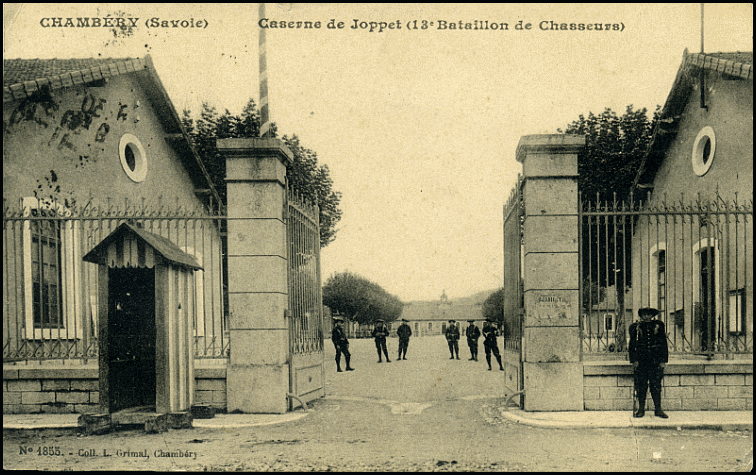
Symbolically, this postcard shows that he has just entered a new world. Behind the men guarding the entrance to the neighborhood, we can see soldiers in drill gear, perhaps attending section school like Jean at the time.

He is not isolated in Savoie, far from Paris: he mentions in his short correspondence that he is going to meet « Jacques » at the quarter. Was he a friend? His « old friend »?

Here he is in his 13th BCA alpine hunter’s uniform, his 19-year-old face unmarked by the moustache so common on the faces of the time. He was immortalized in the barracks by a photographer from Chambéry, and bought at least two prints glued to cardboard. The specific features of the alpine hunter’s uniform can be seen: the beret, the model 1891 Dolman jacket with its turned-down collar (which can be turned up in bad weather) and the shoulder pads designed to prevent the shoulder straps from slipping off; the last specific feature is the calf straps.
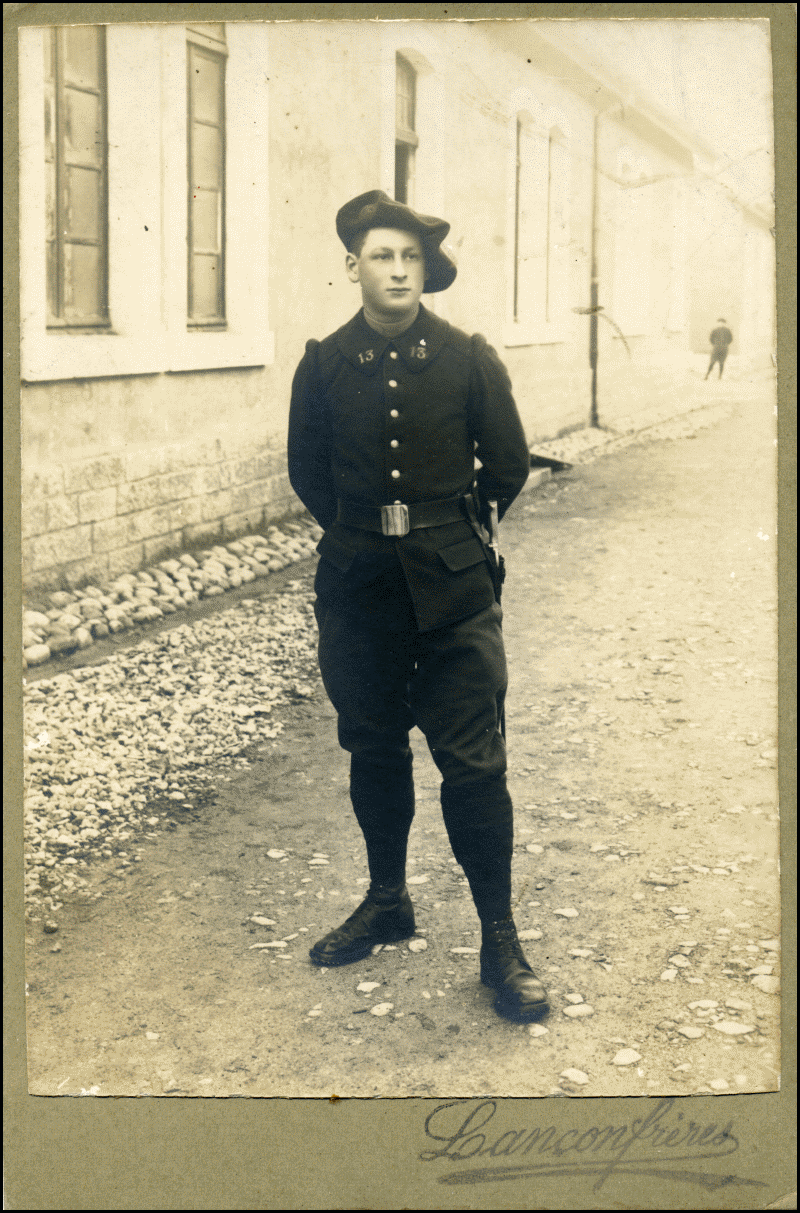
In January 1914, he sends a photo-card to his family. In a snowy landscape, he is clearly visible, still without a moustache, among a group of over seventy alpine hunters, probably a large part of his company. He has taken care to mark his presence with an arrow.
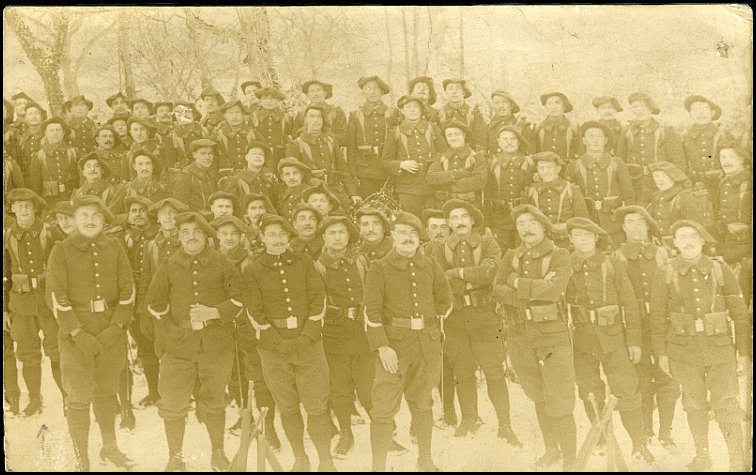

He writes that he’s hoping for leave, but won’t be sure of coming until he’s on the train. How many times did he see his family during this period in Chambéry? Paris is a long way away. Note that the card is addressed to his mother alone. The reference to a battalion at the top of the card is later.

The last surviving correspondence was written just before Jean left for Lyon to sit an exam. However, he does not specify which exam. The front shows him with another group of alpine hunters: these are the cadets of the class of 1913. There’s no mistaking it, it’s right there on the picture. Jean had therefore taken the course to become a corporal, a further argument for the idea that he hadn’t simply enlisted to get ahead of the call-up, but to make a career of it. This could be confirmed if the exam in question was to enter a military academy.

Once again, despite the absence of an arrow, Jean’s identification is unmistakable: he has placed his bag in front of him and holds his Alpenstock in his hand. However, unlike his neighbor, we can’t see his snowshoes, as he has placed his bag so that we can see the label indicating his corps number and name!

He is writing to someone called « J. Charlon », who lives in the 17th arrondissement of Paris, in the early summer of 1914, at the end of June to be precise. The vegetation is in leaf, as it is in the last photograph, undated but perhaps taken at the same time as the previous one. However, it was not taken on the same day, as its collar does not bear the sticker indicating that its uniform is that of an instructor.
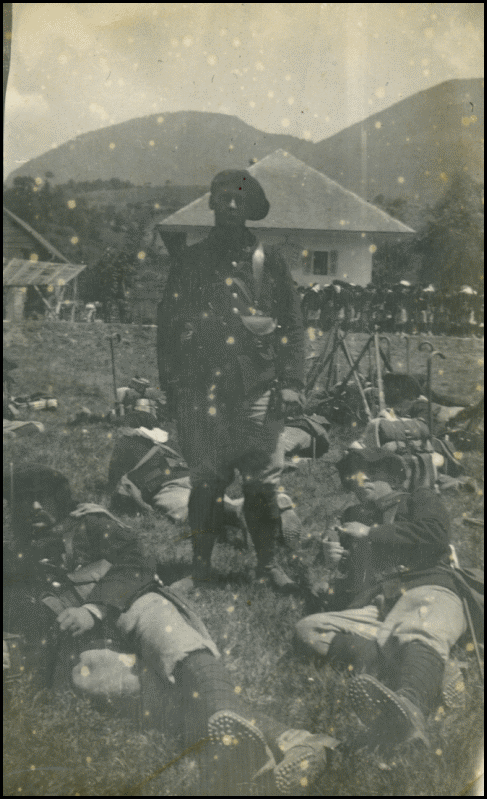
Despite the poor quality of the photo, taken against the light, Jean is once again recognizable in the center. He is standing amidst a group of resting comrades. A group of chasseurs is gathered in the background. Was it taken during a march, an exercise, a maneuver, during the last training sessions in the mountains in July? There’s no caption this time to say.
- And then came the war
After being put on alert at the end of July, the regiment left Chambéry on August 5 and arrived in Épinal on the 6th. The battalion arrived in the combat zone around Gérardmer on the night of August 14. It was temporarily placed under the orders of the 81st infantry brigade and, once it had crossed the border at the Col de la Schlucht, fought in Alsace, in the Munster region.
Only the JMOs of the 41st Infantry Division, the 81st Infantry Brigade and the history of the 13th BCA, in the absence of a JMO for the battalion, provide us with the major stages in the career of the unit at the heart of which Jean is to be found.

1. August 15: Combat at SULTZERN, 10 killed, 39 wounded
2. August 16: Combat in front of MUNSTER, 3 killed, 10 wounded
- September 3rd, 1914
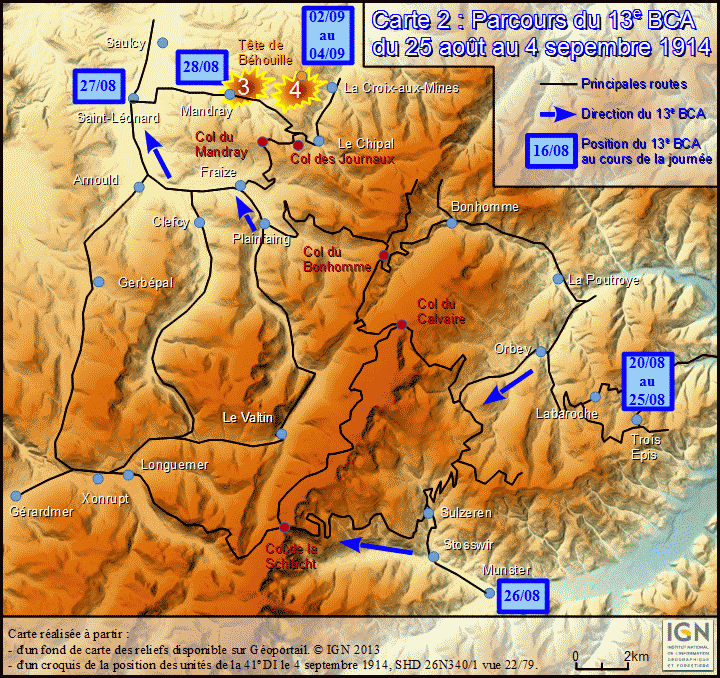
3. August 27 to 30: Fight around Mandray, 57 killed, 128 wounded.
4. September 2 to 4: Fight at Béhouille head, 125 killed, 271 wounded.
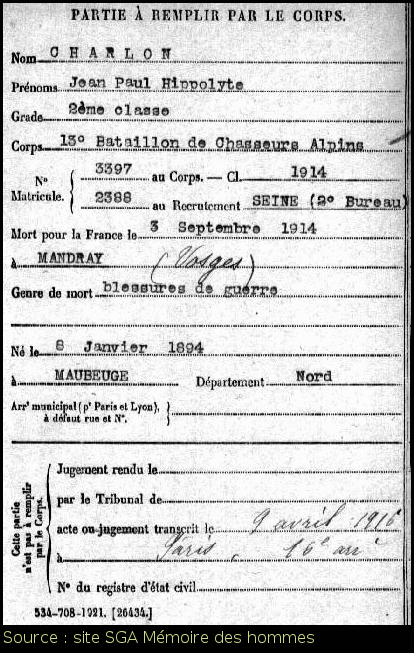
It is difficult to determine the circumstances that led to Jean Charlon’s death. Was he mortally wounded, as his « Mémoire des Hommes » entry suggests, or « killed in action », as his obituary entry in the visitors’ book of his former lycée indicates? There’s no doubt about where he was: he was hit during the fighting at the head of Béhouille, where the battalion lost 125 killed and 271 wounded in three days of fighting, according to its history.
Lycée Janson de Sailly guestbook entry for Jean Charlon, page 20: CHARLON, Jean, soldier in the 13th Battalion of Alpine Chasseurs. Killed in action on September 3, 1914 at La Tête-de-Béhouille (Vosges).
When he fell in September 1914, his class of 1914 had just begun to be called up.
Did he know the result of his exam before he left? Had he failed to become a corporal, or had his training not been completed when the war began? In any case, he was only second class when he was killed.
Was his body buried individually? Did his comrades have time? His adversaries? The intensity of the fighting during this period, and his absence from the « Sépulture de guerre » database, do not seem to lead to this conclusion. But perhaps his family was able to have his body repatriated after the war?
His name only appears in the visitors’ book of the 17th arrondissement of Paris. In the absence of a homonym in the « Mémoire des Hommes » files, and insofar as a member of his family lived in this arrondissement, it is highly probable that it was him. This question, like others, remains unanswered. The registration card could shed light on some of them. But, like many of the servicemen who shared the same fate in the summer of 1914, many points remain inaccessible to us.
- Update:
Thanks to Eric Mansuy, we now know a little more about Jean Charlon’s burial. As for his original burial, a survey of graves in the commune of Mandray mentions his name.

He was therefore originally buried at La Béhouille.
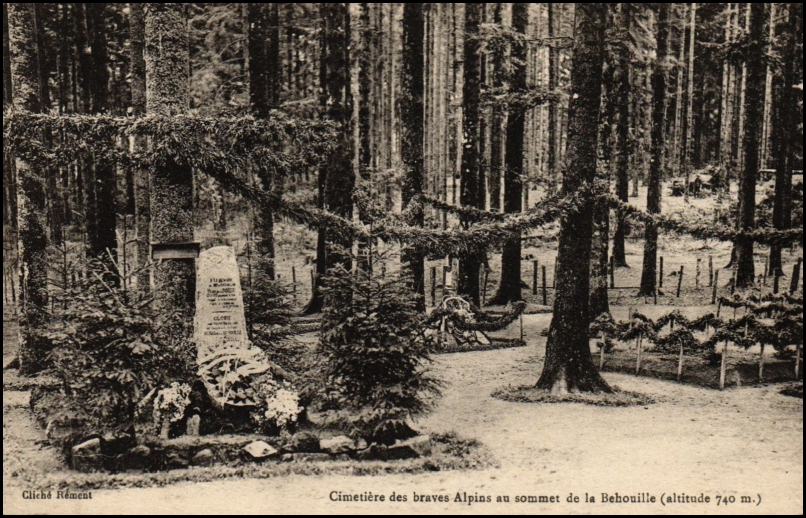
- Acknowledgements
To Eric Mansuy for information on Jean Charlon’s burial and to Jérôme Charraud for information on the 13th BACP.
- Sources :
Archives de Paris
16D 108 : état civil du 16e arrondissement de Paris, acte n°792, transcription de l’acte de décès de Jean Charlon, 9 avril 1916.
D4R1 1791 : fiche matricule de Jean Paul Hippolyte Charlon, classe 1914, matricule 2388 au bureau de recrutement de la Seine 2e bureau.
Autres sources :
Acte de naissance de Jean Charlon, AD du Nord, Maubeuge 1894, 1 Mi EC 392 R 012, vue 13/580.
Dossier de la Légion d’honneur de Jean Charlon (père) : 19800035/0215/28220
C. Chacornac et Lucien Poincaré, Discours prononcés à la distribution des prix le 13 juillet 1915 : livre d’or, Lycée Janson de Sailly. Melun, imprimerie administrative, 1915. Accès direct sur Gallica.
Anonyme, Historique du 13e bataillon de chasseurs alpins (1914-1918), Chambéry, Imprimerie chambérienne, 1920. Accès direct sur Gallica.
JMO de la 81e brigade d’infanterie, SHD 26N519/1. Accès direct.
JMO de la 41e division d’infanterie, SHD 26N340/1. Accès direct.
Dekerle S., Mirouze L., L’Armée française dans la Première Guerre mondiale – Uniformes, équipements, armements, Tome 1 1914, Vienne (Autriche), Editions Verlag, 2007. Informations sur les uniformes de chasseurs alpins de la page 176 à la page 181.
Herniou Yvick, Labayle Eric, Bonnaud Michel, Répertoire des corps de troupe de l’armée française pendant la Grande Guerre, tome 2, chasseurs à pied, alpins et cyclistes, Éditions Claude Bonnaud, 2007, pp. 82-85.
- Compléments :
Un complément et un outil de référence pour tout ce qui concerne les chasseurs alpins avant-guerre et pendant la Première Guerre mondiale : le site des chasseurs alpins
Sur le cimetière de la Béhouille
Publication de la page : 31 mars 2013 – Mise à jour : 11 août 2024.
